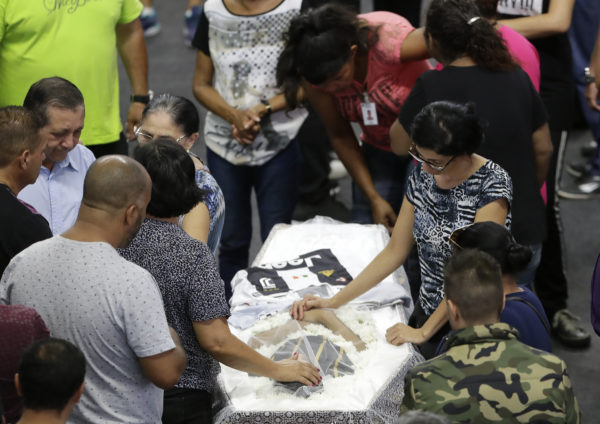SUZANO, Brazil (AP) — Classmates, friends and relatives of the victims of a mass school shooting hugged, cried and prayed on Thursday as several thousand attended a wake in this devastated Sao Paulo suburb while authorities worked to uncover what drove two former students to attack with a gun, crossbows and axes.
Before 17-year-old Guilherme Taucci Monteiro and 25-year-old Henrique de Castro launched the school assault Wednesday, killing seven, police said they shot and killed a man who owned a used-car dealership nearby.

A relatives mourn Kaio Lucas da Costa Limeira, victim of the shooting at the Raul Brasil State School during a collective wake of the victims in Suzano, greater Sao Paulo area, Brazil, Thursday, March 14, 2019. (AP Photo/Andre Penner)
What happened next at the K-12 school, partially caught on surveillance camera footage at the school’s entrance and widely distributed in Brazil, was stomach-churning.
It showed Monteiro entering the building and shooting several people in the head as they tried to run away. De Castro followed him, first striking wounded people with an ax and then swinging it wildly while scores of students ran past him. De Castro then armed his bow and walked further into the school.
The dead included five students, a teacher and a school administrator. Nine others were wounded in the attack, including seven still hospitalized Thursday.
“I couldn’t sleep. I have two children in school and they are about the age of the victims,” said Wanda Augusta, a 46-year-old homemaker attending the wake.
“If only we could have identified the difficulties of these boys” before the attack, said Rossieli Soares, the state education secretary, who attended the wake at a volleyball arena. “This is a problem in our society.”
Police seized computers and notebooks from the homes of the two attackers, who were neighbors and lived less than a mile (kilometer) from the school. They also took computers from an arcade near the school that the attackers frequented.
TV Globo, citing access to the preliminary police investigation, reported that the attackers had planned the crime for a year and did internet searches of mass shootings at U.S. schools. In particular, the two were interested in the Columbine massacre in Colorado in 1999, according to Globo. Police were expected to detail their investigation at a news conference later Thursday.
While Latin America’s largest nation has deep problems with violence — it’s the world leader in annual homicides — school shootings like those in the U.S. are rare. Wednesday’s attack reminded many Brazilians of an attack in 2011, when a gunman roamed the halls of a Rio de Janeiro school and killed 12 students.
Joao Camilo Pires de Campos, Sao Paulo state’s public security secretary, summed up what was on the minds of many Brazilians.
“The big question is: What was the motivation of these former students?” he told reporters Wednesday.
Monteiro’s mother, Tatiana Taucci, offered a possible partial answer, saying that her son had been bullied at the school.
“Bullying, they call it. … He stopped going to school … because of this,” she told the Band News TV network.
Still, she said she was as surprised as anyone by her son’s involvement in the attack, which she said she heard about on television like everyone else.
Minutes before the school rampage, Monteiro posted 26 photos on his Facebook page, included several with a gun and one that showed him giving the middle finger as he looked into the camera.
In some of the photos, he wore a black scarf with a white imprint of a skull and cross bones. No text accompanied the posts.
During the attack, Monteiro opened fire with a .38 caliber handgun and de Castro used a crossbow, de Campos said.
The attackers were also carrying Molotov cocktails, knives and small axes, authorities said.
One of the wounded, Jose Vitor, ran to a hospital close to the school with an ax still lodged in his right shoulder.
“He is an agile adolescent,” his mother, Sandra Regina Ramos, told reporters outside the hospital. “He reacted quickly.”
The assailants were trying to force their way inside a room at the back of the school where many students were hiding when police arrived. Instead of facing the officers, Monteiro shot de Castro in the head and then shot himself, authorities said.
The debate over whether to expand access to guns, a priority of President Jair Bolsonaro’s administration, was present in many of the public statements by politicians. Soon after his Jan. 1 inauguration, Bolsonaro issued a decree making it easier to buy a gun. His party plans to put forward legislation that would go even further, loosening restrictions on carrying and the number and types of firearms Brazilians can own.
“We can’t let those who take advantage of this tragedy speak about how disarmament is the solution,” tweeted Sen. Major Olimpio, a member of Bolsonaro’s party and a proponent of loosening gun legislation, after the massacre.
Late Wednesday, House Speaker Rodrigo Maia criticized arguments that more guns would help.
“I hope that some don’t try to defend the idea that if only the teachers had been armed, the problem would have been resolved,” Maia told reporters in the capital, Brasilia. “For the love of God.”